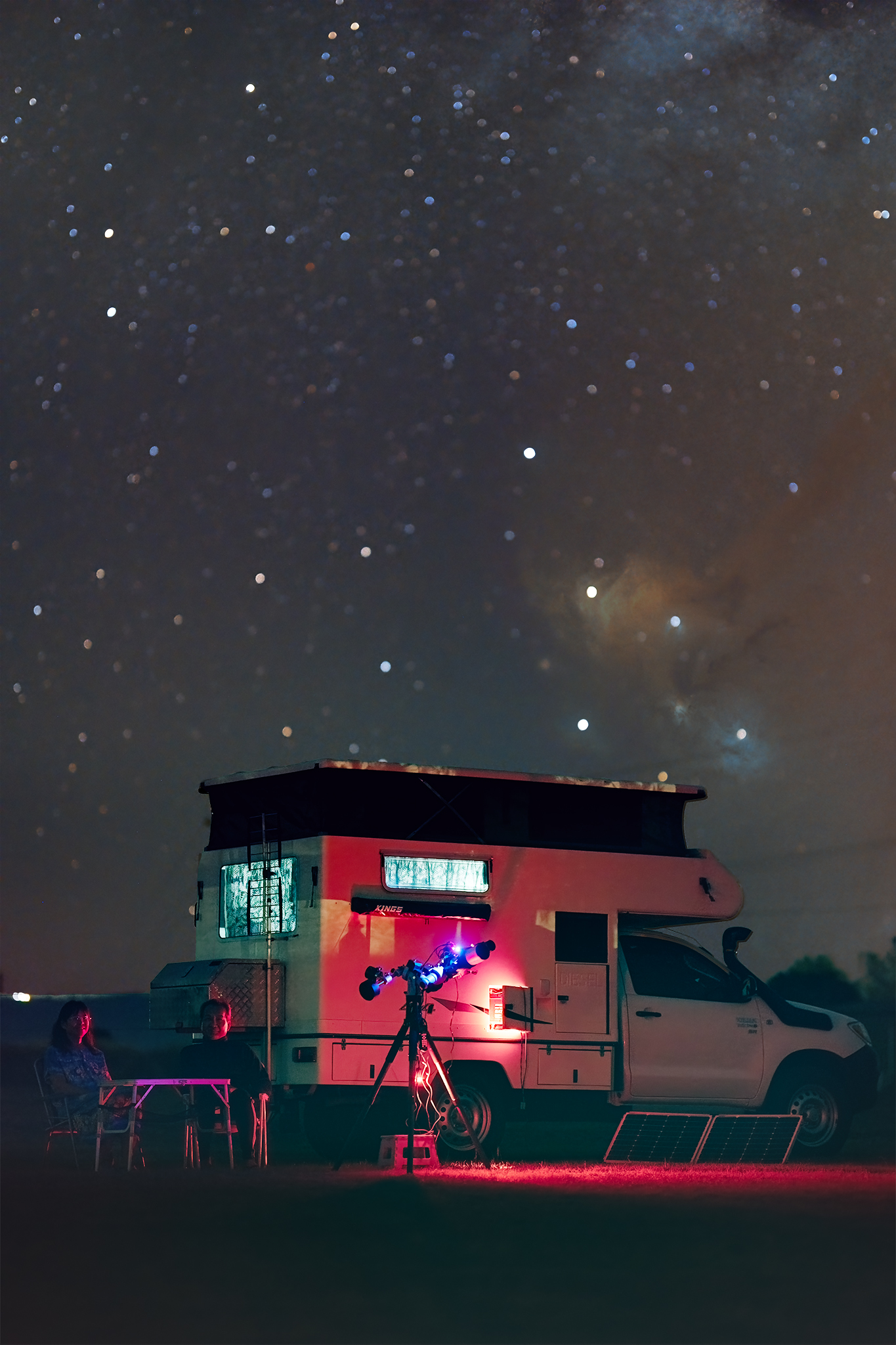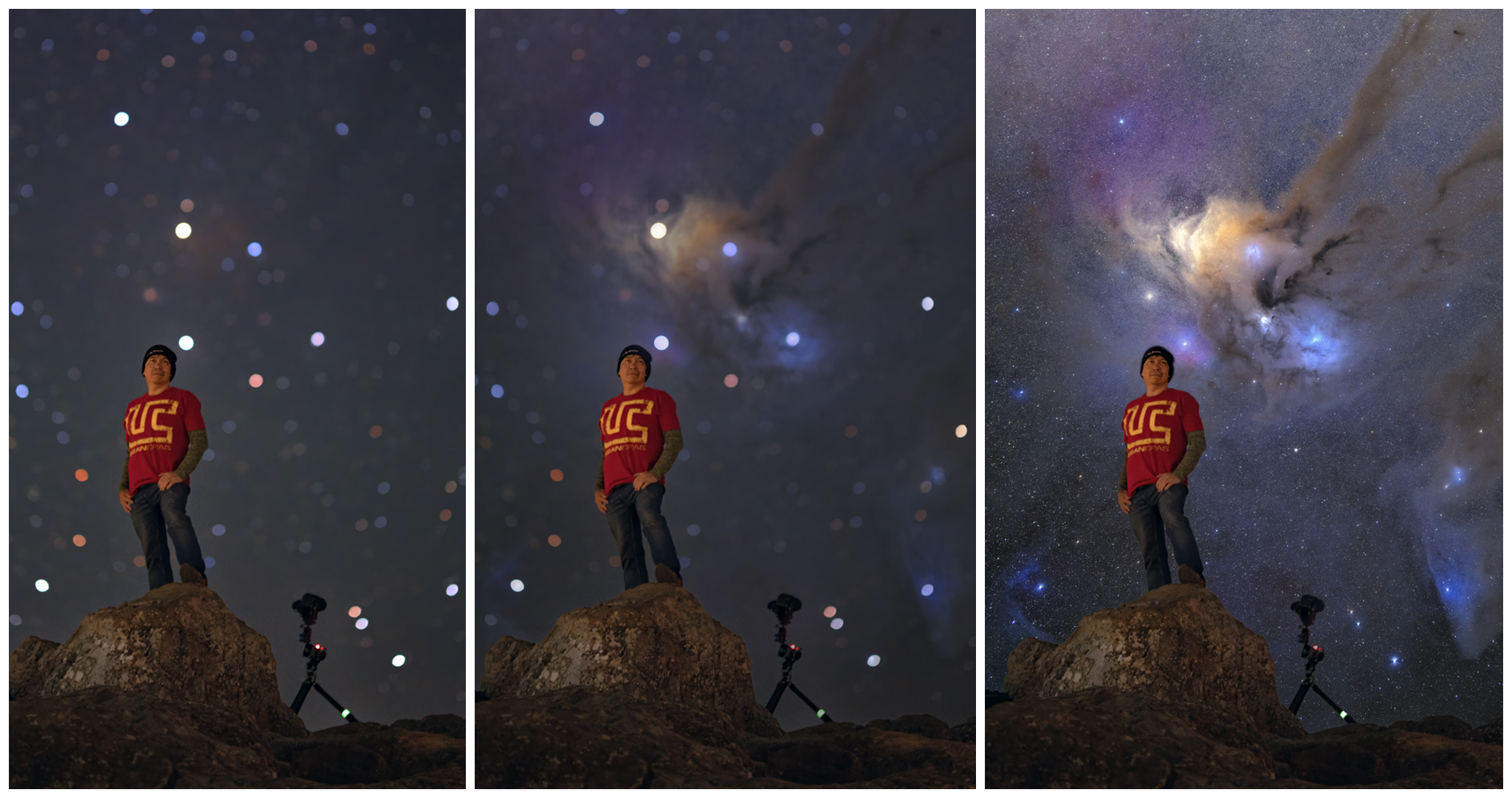Deepscape Astrophotography
by Dennis Mellican

A contemplative moment with Rho Ophiuchi
Deepscapes present celestial scenes that transcend the limitations of our unaided eyes, showcasing deep sky objects set against the backdrop of Earth’s landscape, structures and inhabitants.
A provocative style of astrophotography, it merges the field of Deep Space Astrophotography with Nightscapes. In the field of Deepscape photography, a telephoto lens is directed towards a Deep Space Object (DSO). Ideally, photographers aim to use the same focal length to capture the foreground from the exact location and on the same night. These virtues are also shared with Nightscape photographers.
Despite the utilization of techniques such as color manipulation and the capture of sub-exposures over extended periods by astrophotographers specializing in DSOs, the controversy surrounding Deepscape arises from the deliberate use of lens compression and depth of field. This occurs even when Hyperfocal distance 1 is achieved while combining the DSO with the foreground, often resulting in visually striking yet potentially unnatural outcomes. This optical illusion draws parallels with how the moon may appear larger next to a building. However, in Deepscape photography, the targeted DSOs extend across dimensions far beyond that of moons, leading to a distinctive and unconventional composition.

If people sat outside and looked at the stars each night, I’ll bet they lived a lot differently - Calvin & Hobbes.
To ease into the field of Deepscape photography, this image of two joyful campers at a Star Party has a subtle trace of the Rho Ophiuchi Cloud Complex in the background. This image employs a shallow depth of field, creating a blurred backdrop that transforms stars into expansive bokeh circles, with the intricate structure of the DSO barely discernible.
This particular Deepscape style is visually more appealing, making it easier for our brains to embrace the DSO in the background.

The Bokeh Master meets Rho Ophiuchi
As we gently move further into the realm of Deepscape photography, this triptych encapsulates contemplative scenes atop Mount Ngungun. The progression of images emulate what a magical single shot might achieve, transitioning from bokeh to an in-focus Rho Ophiuchi Cloud Complex. The first panel showcases a shallow depth of field, capturing vibrant and creamy bokeh circles of the starry night in a single 4-second exposure, with careful posing to maintain clarity. The subsequent panel shifts focus to unveil the fiery heart of the Scorpius constellation, featuring Antares surrounded by golden-orange clouds. The final panel reveals the Rho Ophiuchi Cloud Complex and the Blue Horsehead Nebula, with in-focus stars aligning seamlessly with the bokeh panels.
Both the bokeh and in-focus elements were captured using the same equipment configuration in separate instances, with the middle panel serving as a composite of both. This amalgamation allows the viewer to comprehend the Deepscape transition.
Although the last panel is surreal, it serves as a vivid illustration of the noticeable contrast in size between the DSO and the subject, as seen from this vantage point on Earth. This is the essence of Deepscape photography.
I tend to favour a personal style that incorporates bokeh stars alongside seamlessly aligned deep-sky objects, making the middle panel of the triptych my preferred choice. Thus, the title “The Bokeh Master meets Rho Ophiuchi” alludes to the Sigma “Bokeh Master” 105mm f/1.4 Art lens employed in the photography. Which panel appeals to you?
Top 5 Deepscape Targets
Begin with these Deep Space Objects (DSOs) and recommended focal lengths, juxtaposed against your selected foreground:
- Rho Ophiuchi Cloud Complex: Utilize a 105mm lens.
- Orion Complex: Optimal with a 50mm lens.
- Andromeda Galaxy: Best captured with a 135mm lens.
- Large Magellanic Cloud: Ideal choices are a 105mm or 135mm lens.
- Milky Way Core: Well-suited for a 50mm lens.
Additional appealing targets include the Carina Nebula, comets and although not a Deep Space Object, the Moon. Surprisingly, our nearest celestial companion garners more attention than any other object in my astrophotography collection!
Helpful Tools
Several factors come into play when setting up a shot, with the positioning of the Deep Space Object relative to your foreground subject in the sky being crucial. Here are some resources I find valuable for planning:
-
Stellarium: I rely on the online version to get a rough guide on the DSO’s position relative to the location and time.
-
PhotoPills: The Plan feature is a cornerstone for precise framing.
-
Hyperfocal Tables: This is useful for capturing sharp stars and foreground in the same sub-exposure. Even if you plan to create a composite by blending a foreground with a separate DSO stack, the hyperfocal image serves as a reference for aligning layers in post-production. PhotoPills offers a customizable hyperfocal table based on your focal length and aperture.
-
Augmented Reality (AR): AR is employed during scouting or on-site to visually preview the frame before the actual event. Most AR apps can fast forward in time to assist with planning. PhotoPills, as mentioned earlier, has this feature, but other astronomy apps like Sky Safari, Stellarium, and Sky Portal also incorporate AR capabilities.
-
Hyperfocal distance is the specific focusing distance at which a camera lens will produce the maximum depth of field, keeping objects from a certain distance to infinity acceptably sharp. In other words, when you focus your lens at the hyperfocal distance, it ensures that everything in the frame, from a certain point (the hyperfocal distance) to infinity, appears in focus. ↩︎